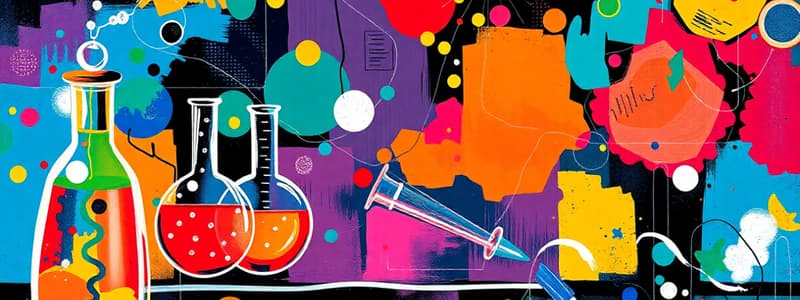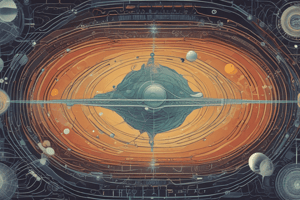Podcast
Questions and Answers
A researcher is designing an experiment to test the effect of fertilizer concentration on plant growth. What represents the most appropriate approach to formulate a hypothesis?
A researcher is designing an experiment to test the effect of fertilizer concentration on plant growth. What represents the most appropriate approach to formulate a hypothesis?
- If the fertilizer concentration is increased, then the plant growth will increase because plants require nutrients to grow. (correct)
- Observe the plants and record growth patterns without any manipulation.
- Measure the height of the plants weekly and compare the results.
- Consider results from previous experiments.
Inferences are always correct if they are based on previous knowledge or experience.
Inferences are always correct if they are based on previous knowledge or experience.
False (B)
Why is peer review an essential step in the scientific method?
Why is peer review an essential step in the scientific method?
To check for errors and confirm the validity of findings.
When outlining an experiment, it's important to identify the ______ variable, which is the factor that is manipulated by the researcher.
When outlining an experiment, it's important to identify the ______ variable, which is the factor that is manipulated by the researcher.
Match each type of observation with its correct description:
Match each type of observation with its correct description:
The scientific method begins with a question that serves as the ______ point for investigation.
The scientific method begins with a question that serves as the ______ point for investigation.
A ______ is a prediction in the 'If-Then-Because' format that is based on already proven facts and provides a possible answer to a question.
A ______ is a prediction in the 'If-Then-Because' format that is based on already proven facts and provides a possible answer to a question.
The experimental design should contain a brief description of the experiment's ______, outlining the steps to be followed.
The experimental design should contain a brief description of the experiment's ______, outlining the steps to be followed.
In experimental design, it's crucial to identify the independent and ______ variables to understand cause-and-effect relationships.
In experimental design, it's crucial to identify the independent and ______ variables to understand cause-and-effect relationships.
[Blank] observation involves describing the qualities of an object using the senses.
[Blank] observation involves describing the qualities of an object using the senses.
[Blank] observation involves making measurements and counting.
[Blank] observation involves making measurements and counting.
An ______ is a logical interpretation or conclusion based on observations and prior knowledge and is not necessarily correct.
An ______ is a logical interpretation or conclusion based on observations and prior knowledge and is not necessarily correct.
When analyzing experimental results, it's essential to evaluate the ______ of materials and equipment, as well as any measurement errors.
When analyzing experimental results, it's essential to evaluate the ______ of materials and equipment, as well as any measurement errors.
Before publishing their work, scientists go through a process called ______ to check for errors and validate evidence.
Before publishing their work, scientists go through a process called ______ to check for errors and validate evidence.
The scientific method starts with asking a ______ question and developing a hypothesis.
The scientific method starts with asking a ______ question and developing a hypothesis.
After performing an investigation, a scientist draws a ______ and compares it to their hypothesis.
After performing an investigation, a scientist draws a ______ and compares it to their hypothesis.
When brainstorming a scientific question, scientists consider factors they can measure or observe, which are also known as possible ______ variables.
When brainstorming a scientific question, scientists consider factors they can measure or observe, which are also known as possible ______ variables.
In experiment preparation, identifying the variables and their categories is crucial, including understanding how changing one variable will affect another, often described as '______, then that.'
In experiment preparation, identifying the variables and their categories is crucial, including understanding how changing one variable will affect another, often described as '______, then that.'
The scientific method, as depicted in the text, involves several key parts, including brainstorming, preparing for the experiment, performing the experiment, and ______.
The scientific method, as depicted in the text, involves several key parts, including brainstorming, preparing for the experiment, performing the experiment, and ______.
When designing an experiment to determine how many drops of water can fit on a penny, factors like the year of the coin and the size of the dropper are considered possible ______.
When designing an experiment to determine how many drops of water can fit on a penny, factors like the year of the coin and the size of the dropper are considered possible ______.
Experts are interested in two main things during peer review: Evidence and ______.
Experts are interested in two main things during peer review: Evidence and ______.
Flashcards
Ask a Question
Ask a Question
A testable question that starts the scientific method.
Formulate a Hypothesis
Formulate a Hypothesis
A prediction based on existing knowledge, structured as "If-Then-Because."
Qualitative Observation
Qualitative Observation
Describing an object using your senses.
Quantitative Observation
Quantitative Observation
Signup and view all the flashcards
Inferences
Inferences
Signup and view all the flashcards
Hypothesis
Hypothesis
Signup and view all the flashcards
Experimental Design
Experimental Design
Signup and view all the flashcards
Independent Variable
Independent Variable
Signup and view all the flashcards
Dependent Variable
Dependent Variable
Signup and view all the flashcards
Control Variables
Control Variables
Signup and view all the flashcards
Plotting Graphs
Plotting Graphs
Signup and view all the flashcards
Evaluating Evidence
Evaluating Evidence
Signup and view all the flashcards
Hypothesis Support
Hypothesis Support
Signup and view all the flashcards
Research Usefulness
Research Usefulness
Signup and view all the flashcards
Peer Review
Peer Review
Signup and view all the flashcards
Communicate Evidence
Communicate Evidence
Signup and view all the flashcards
Scientific Method
Scientific Method
Signup and view all the flashcards
Brainstorming
Brainstorming
Signup and view all the flashcards
Possible Variables
Possible Variables
Signup and view all the flashcards
Preparing for Experiment
Preparing for Experiment
Signup and view all the flashcards
Study Notes
Initiating and Planning
- The starting point is asking a question
- A hypothesis is related to the experiment question, based on proven facts, and is a prediction of "If-Then-Because" that provides a possible answer
- Experimental design briefly describes the procedure of the experiment
- Identify the independent and dependent variables
- Determine how changes in the variables will be measured, specifying how to control the variables
- Specify how to control the variables not being tested
- Select appropriate equipment and materials
- Identify and address safety concerns
- Decide on a format for recording observations
Performing and Recording
- Qualitative observation describes the qualities of an object with the senses
- Quantitative observation is based on measurements or counting
- An inference is a logical explanation for an observation based on past experience and prior knowledge, but is not necessarily correct
Analyzing and Evaluating
- Plotting graphs for quantitative measurements to show patterns and trends, while also finding any errors in measurement
- Evaluate evidence by evaluating the quality of everything else in the experiment
- The overall purpose is to answer any questions at the start of the investigation
- Evidence can either provide the required answer to the question, or not provide enough evidence
- Conclude if a hypothesis is supported by the results; both supported and unsupported results are valuable
- Failing to support a hypothesis does not mean it is a failure
- Experiments can be repeated to ask new questions
- Consider if the information is actually useful or valuable
Communicating
- After an experiment, scientists go through peer review before publishing their work
- Experts check for errors with communication as well as for the evidence and procedures used to gather the evidence
- This is important if anyone wants to repeat the experiment
- Evidence can be communicated through reports or presentations
General Overview
- The scientific method enables scientists to study the world
- It is an organized way of figuring something out, and it can be used to study anything
- General steps of the scientific method are:
- Asking a testable question and developing a hypothesis/answer
- Performing an investigation and analyzing/observing it
- Drawing a comparison of the conclusion to the hypothesis
- No two scientists do the scientific method exactly the same way; methods often vary greatly
Studying That Suits You
Use AI to generate personalized quizzes and flashcards to suit your learning preferences.
Description
Explore the scientific method: asking questions, forming hypotheses, and designing experiments. Learn about qualitative and quantitative observations, and the importance of data analysis. Understand how to draw conclusions and the value of disproven results.




